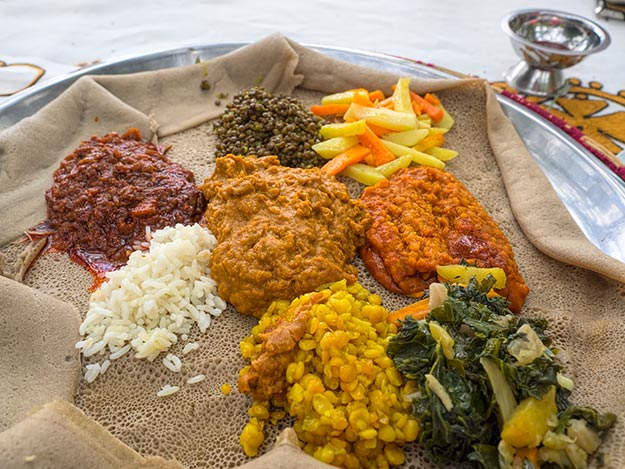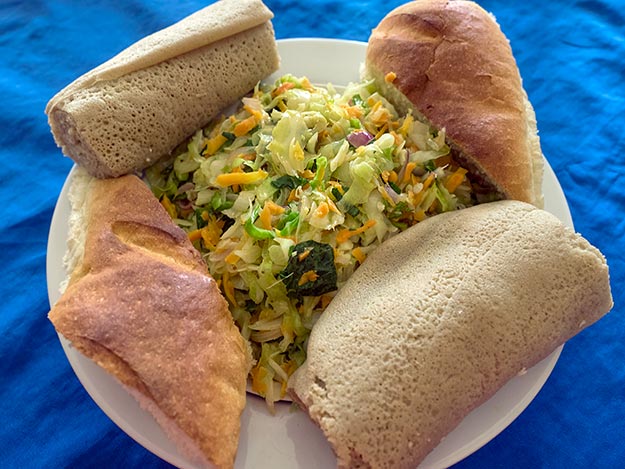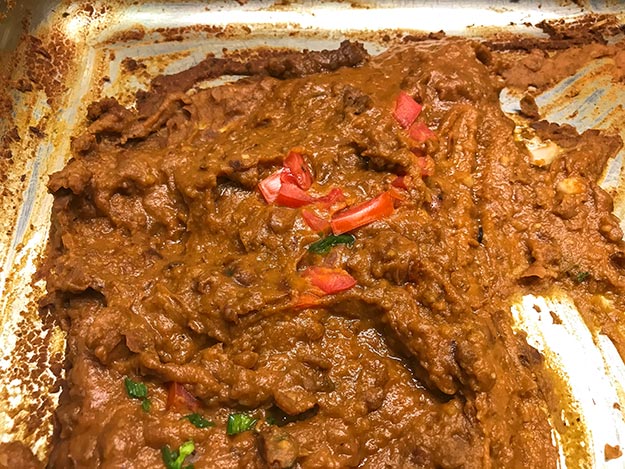I LOVE Ethiopian cuisine. I was first introduced to it 12 years ago, in Tanzania. I took one bite of Injera, the spongy, sourdough flatbread that Ethiopians use to scoop up everything on their plate, and was immediately hooked. Not only is Injera delicious, it’s made with fermented teff flour, which is milled from a Gluten-free seed rather than a grain. So it follows that the bread must also be devoid of carbohydrates and empty calories, right? Okay, okay, I’m delusional. But it’s what I told myself before arriving in Ethiopia. I fully intended to stuff myself with Injera until it was coming out my ears.
It wasn’t just the Injera I was looking forward to. Half of the population of Ethiopia are Orthodox Christian, a religion that forbids eating meat or dairy products on Wednesday and Friday, as well as during the Easter fasting season. As a result, Ethiopian cuisine incorporates a wide variety of vegetarian dishes, the most famous of which is fasting ye’tsom beyaynetu. The meal, which is meant to be shared, arrives on a large round silver platter, draped with an equally large sheet of Injera. Friends around the table tear off hunks of Injera and use it to scoop up the vegetarian dishes mounded on top. The sweet, sour, and spicy flavors of lentil stews, split pea puree, roasted chickpeas, rice, spinach, and sautéed veggies, all accompanied by a fiery roasted red chili paste, explode in your mouth. A beyaynetu is pure ambrosia, even if I have to constantly blow my runny nose and wipe the tears streaming from my eyes because it is hot, Hot HOT!

I arrived in Lalibela, Ethiopia, with visions of delicious dishes dancing in my head. I’d chosen to work with a local tour company, Ethio Travel and Tours (ETT), and was certain that the guest houses they’d booked would allow me to delve deeply into the Ethiopian food scene. After settling into my room at Lalibela Lodge, I made a beeline to the restaurant for lunch and eagerly perused the menu. Spaghetti with tomato sauce or rice with vegetables were the only vegetarian options. Disappointed but starving, I ordered the latter; the rice arrived with no vegetables and a sparse sprinkling of black lentil beans. It was accompanied by a plate of dry bread and local honey. Carbs, carbs, and more carbs. At least I would have enough energy to tackle the rough trails and deep rock-cut staircases at the rock-hewn churches of Lalibela that afternoon. I told myself their dinner menu would offer better options.
It didn’t. I looked down at the same, sorry menu I’d been given at lunch. Fortunately, I wasn’t very hungry, so I just skipped dinner. The next day I complained about the food to my wonderful guide, Misgan. “Don’t worry,” he assured me. “Today I will take you to the Seven Olives Restaurant for their fasting beyaynetu. You will love it.” And I did! I ate myself silly. When I thought I couldn’t eat another bite, I unsnapped my pants and kept shoveling food in my mouth. I even tried jumping up and down to make more room, as my family in Nepal has shown me, but I finally pushed the platter away in defeat. I was blissfully happy and full to my eyebrows. Little did I know that that one meal would have to sustain my craving for traditional Ethiopian food for the next two weeks.

The following morning I flew back to Addis Ababa and headed south in a jeep, bound for the Konso Highlands and Omo Valley. For the next eight days, I visited some of the 56 ethnic tribes that live in this southern region of the country. Each day I was dropped of at one or another resort for lunch. And each day I struggled to find something to eat. At the Kanyalak Lodge in Konso, they offered to make me tomato soup but it would take longer than I was allowed for lunch break. I ordered the only thing on the menu I could eat: a mango. Ravenous, I wolfed it down, but I was still starving. Another mango, please. And tea. Dinners were mostly limited to Injera (at least I was getting my fill of that) and Shiro, a pureed stew made from broad beans or chickpeas. I scoffed at the pizza, pasta, and bland rice dishes on offer, and the only available vegetables seemed to be carrots or cabbage.
Another day we pulled into the Kizo Lodge in the tiny town of Turmi. We’d spent a blistering hot day visiting the Hamer tribe and I was famished. Their menu was even more abysmal, offering only Shiro, tomato soup, or rice and vegetables. “What kind of vegetables?” I asked (there’s only so much Shiro a person can eat). They couldn’t tell me in English, so I suggested they take me to the kitchen and show me. Ducking beneath a low door in the rough concrete wall, I followed my server across an uneven floor to the refrigerator. He tugged open the door to reveal a cavernous emptiness. A half dozen mushy tomatoes dotted with black mold spots lined the top shelf inside the door. He reached down to the bottom compartment and retrieved the only other item inside the fridge, a tall, unlabeled tin can that had been shoved all the way to the rear. An inch and a half of what appeared to be tomato paste remained in the bottom. “We make tomato soup?” he asked. “Noooooooo!” I shook my head. God knows how long that uncovered can had been there. He offered to make me a Spanish Omelette, but I was certain they would use the moldy tomatoes. No way I was eating there. Ptomaine poisoning is not high on my experiential wish list.

Taking pity on me, my driver took me to the Buska Resort, said to be the best place in town. Indeed, they did have a nice restaurant with several Western vegetarian items on their menu. Unfortunately, the only vegetables they had on hand were carrots and cabbage (where had I heard this before?). I’d woken up that morning with an upset stomach from the garlic rice I was forced to eat the previous evening, so I didn’t think gas-producing cabbage was a very good idea. Playing it safe, I ordered French Toast. By the time we got back to Kizo Lodge, all I wanted to do was take a shower and go to sleep. I stepped into the shower and turned the knob for hot water. Nothing. I tried the cold water handle. Again, nothing. It was late, pitch black, and eerily quiet except for animal and insect sounds. Finding anyone to help would require wandering around alone in the dark with a flashlight. I sighed, climbed beneath the mosquito netting, and lay spread-eagle, trying to keep any one part of my sticky, smelly body from touching another part.
I wish I could say the Ethiopian cuisine was better in Jinka, but the tomato soup I ordered was so putrid that I spit it out, and the steamed rice was soggy and bland. The only saving grace was the fresh papaya and banana they served for desert, with marvelous freshly brewed Ethiopian coffee. My only decent meal in the Omo Valley came on the day we visited Mago National Park. As we were checking out of the park, my guide led me down into a clearing where members of the Ari tribe were having a breakfast. They offered me a bowl of cooked sorghum beans with spicy chili and Moringa, the leaf of a local tree used to treat more than 16 diseases and conditions. Maybe I was just starving by that point, but it was absolutely delicious and, to their delight, I wolfed down an entire bowl. My final meal in the south was a cheese pizza. It tasted like cardboard, but it was better than nothing.
At the Danakil Depression, it was more of the same, but at least they had a legitimate excuse. Danakil is one of the most remote, harshest environments in the world. Not only is it the place on earth with the hottest average temperature, the landscape is a bizarre conglomeration of salt flats, acid-spewing geysers and sulfur fields, with an active volcano crater full of molten magma to boot. Incredible as it sounds, a few hardy souls actually live here, but there are no hotels or restaurants. We slept under the stars and our meals were typical camp meals of pasta and soup for dinner, eggs and pancakes for breakfast. Understandably, there was no typical Ethiopian food at Danakil.

Back in Addis Ababa at the Elilly Hotel for my last four days, I fared a little better. They had a delicious buffet breakfast every morning with a selection of vegetarian dishes. Among my favorites was fasting Fir Fir (also called Fit Fit), which is shredded pieces of Injera that have been marinated in spices and sauteed with a spicy sauce known as Wat. Another favorite was Foul Moudamas, or simply Foul, which is boiled dried fava beans that are smashed and mixed with chopped vegetables and spices.
Unfortunately, their main restaurant featured mostly Western food. One evening I ordered the Pesto Pasta. Twenty minutes later my server placed a bowl of spaghetti with tomato sauce in front of me. When I hesitated, she inquired if everything was OK. I explained that I’d ordered the Pesto Pasta, and that I don’t like spaghetti with tomato sauce. She took it away, only to return moments later with the same bowl of spaghetti, along with a small dish of pesto sauce. I gave up and ate it.
Not only was the food in Ethiopia a huge disappointment, I’ve now been constipated for the last four days. Thank goodness I’m headed to Greece, where the first thing I’m going to do is order a huge green salad.

this is really amazing and interesting article. thanks for sharing such an amazing article about tale of an Ethiopian food .
If you are ever back in Addis, contact GoAddis Tours. Their food tour is amazing & they can point you in the right direction. We lived in country for a few months in Addis, travelled to Awassa, and never had an issue finding non-carb ridden vegetarian dishes, especially if you were more adventurous & would eat outside of guesthouses and hotels. It sounds like your guide failed you. We’ve travelled to Ethiopia many times & I actually avoid meat while there because you never know how it’s transported or stored.
Hi Samantha: Thanks so much for that recommendation. I made my guides take me to local places several times, but it was a struggle. They really just wanted to dump me at the hotel/resort at the end of the day and every one of those places had horrible food geared to Western tastes. I’ll definitely check out GoAddis next time around.
Oh, dear! This all sounds so disappointing. I’ve had Ethiopian food at market stalls in London and it was amazing so this would be such a let down. I can’t even imagine trying to cope as a vegan!
For me, food is a major part of enjoying my travels. But just being able to eat ANYTHING sounds like it would have been appreciated here!
I’ve had similar disappointing experiences (Croatia stands out!) where I’ve basically lived on variations bread and rice for weeks!
Hope you fared better in Greece. 🙂
How interesting Sarah. I had the opposite experience in Croatia, but along the Dalmatian coast. I suspect that using a more upscale tour company in Ethiopia might have resulted in a different culinary experience. But getting to see Ethiopia was worth the food disconnect.
If you’re a vegetarian I found that its best not to go during the month after easter – because everyone has been on fasting food for a month, lots of places don’t bother with fasting food on Wednesdays and Fridays. I’ll eat anything but my jaw got worn out from inedibly chewy meat and entrails so like you spent most of the time dreaming of beyaynetu. At least you could always find a decent cup of coffee
LOL – that’s certainly the truth Graham. The coffee was delicious. And I appreciate the tip about not going the month after Easter – very interesting.
Great read, Barbara! Too bad about the food, though! That would be disappointing.
It was, Crystal. I find it incongruous that the best Ethiopian food seems to be found outside of Ethiopia. I look forward to the day when I can get back to my favorite Ethiopian restaurants in Amsterdam and Brussels.